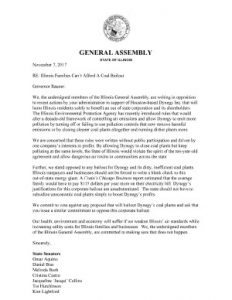Fossil Fuels
Extracting and burning fossil fuels poses varied threats to Illinois waterways, groundwater aquifers, and air quality.

Renewable energy
Illinois is on track to get 25% of its renewables by 2025

energy efficiency
Consumers get the same services for less money

fossil fuels
Burning fossil fuels harms our health and environment

transportation
The transportation sector is now the largest carbon emitter
Coal Pollution in Illinois
Oil and Gas Pollution in Illinois
Sand mining in Illinois is gearing up as the great “frac sand rush” that engulfed Wisconsin and Minnesota makes inroads in Illinois. In fracking operations, sand is mixed with water and chemicals, then injected underground to break apart rocks and unleash trapped oil and gas. The best sand for fracking has quartz grains that are relatively pure, hard enough to withstand pressure, and round enough to allow natural gas to flow around them easily. This kind of sand is not common, however, some of the world’s best deposits occur in the Midwest, with abundant supplies in northern and central Illinois. And as the fracking boom has taken off, so has demand: “frac sand” production could climb 30% from 2013 to 2015, an increase of about 95 billion pounds of sand, according to industry projections.
Frac sand mining threatens Illinois state parks and perhaps the entire Illinois River Valley, which could do serious damage to the fragile ecology of those areas. Negative impacts of these sand mining operations include: noise and dust from blasting and trucks; light pollution from mining operations; disturbance of flora and fauna; destruction of wetlands; drawing down and pollution of water resources; destruction of productive top soils needed for agriculture; and exposure to toxic chemicals and airborne particulate matter. Moreover, the sand is like tiny shards of glass that can lodge in the lungs, a condition similar to asbestosis.
Current Fossil Fuel Laws
Since the early 1990s, new surface impoundments have been required to be lined. There are also requirements for groundwater monitoring well systems and hydrogeologic assessments at facilities. Further, where groundwater contamination has been found, cleanup/remediation is required. IEPA groundwater standards also contain stringent non-degradation requirements.
There are 24 power plants in Illinois with a total of 83 impoundments and one permitted landfill where coal ash is disposed. There are also older ash ponds at many of these facilities. Starting in 2008, IEPA initiated an aggressive strategy to assess the vulnerability of groundwater at power plants with near-by potable wells to determine the potential contamination threat to those wells.
Power plants may determine how to manage their coal ash, but must meet all applicable Illinois regulations. The options include: on-site disposal cell; off-site disposal cell; disposal in surface coal mines; disposal in underground coal mines (wet or dry); disposal in special waste landfills; and beneficial reuse.
Beneficial reuse–used in the manufacture of cement, concrete blocks, wallboard, snow and ice control, aggregate in cement, soil stabilization and as a sub-layer in road construction.
Regulation:
- IEPA Bureau of Water: Construction and operating permits issued in conjunction with National Pollution Discharge Elimination System permits require surface impoundments to be in compliance with Illinois ground- and surface water quality standards including non-degradation requirements.
- The IDNR Office of Mines and Minerals regulates coal ash residue where there is onsite disposal or plans to use ash as part of a reclamation project.
- The IDNR Office of Dam Safety regulates all structures that meet the definition of a dam, as defined in the Illinois Administrative Code. Of the 1600+ dams in the state that clearly fall under the regulations, only about 650 have an active permit. The rest are low hazard dams that do not require active permits, but are still regulated.
IPCB groundwater management zone provisions are consistent with federal closure requirements for solid waste landfills..
Signed into law on June 17, 2013. The result of extensive negotiations among industry groups, environmentalists, state legislators, and state agencies, it is one of the most stringent laws on hydraulic fracturing in the nation.
Protections Against Water Pollution:
- Prohibition on open-air ponds for wastewater storage to minimize the risk of water pollution (except temporarily in unforeseeable circumstances).
- Provides protections against water pollution by requiring that: (a) wastewater be reused in fracking or injected deep underground, (b) wastewater be tested for dangerous chemicals and (c) wells be shut down if fracking fluid is released outside of the shale rock formation being fractured.
- Requires both baseline and periodic post-fracking testing of surface water and groundwater sources near fracking wells so pollution can be quickly and easily identified.
- Places the onus on fracking companies to prove that contamination of water sources near the well site was not caused by fracking.
- Mandates the largest setback of any state from public water supply intakes.
- Protects against contamination by requiring numerous best engineering practices for well construction, casements and maintenance.
Transparency and Public Participation:
- Chemical disclosure requirements for both before and after fracking occurs (base fluids, additives, and chemicals).
- Provisions to ensure that only qualified trade secrets are protected, that the public can challenge trade secret designations, and that health needs trump companies’ right to protect chemical information.
- Requirements that fracking permit applicants submit a water management plan describing the source of water to be used for fracking, the location where that water will be withdrawn, the anticipated volume and rate of each water withdrawal, the months when withdrawals will take place, and post-fracking reporting of the total water used and the locations from which the water was withdrawn.
- Notice of the permit application is published twice in a local newspaper and sent directly to owners of property near the proposed well site and is made available for public comment for 30 days.
- Anyone who may be adversely affected by the permit may request a public hearing, where parties may present evidence and cross-examine witnesses. Final permit decisions are subject to judicial review.
- Any adversely affected persons may sue (a) fracking companies for violations of the Act, and (b) the IDNR for failure to perform its duties under the Act.
Other Key Provisions
- Applicants must describe methods they will use to minimize water withdrawals and adverse impact to aquatic life from those withdrawals.
- Fracking companies are required to capture natural gas and put it to beneficial use unless they demonstrate that it would be technically infeasible or economically unreasonable to do so, in which case, they must flare the gas.
- If a noticeable earthquake occurs which can be traced to the deep underground wells where fracking waste is injected, IDNR will adopt rules to monitor seismic impacts and limit injection activity.
- The IDNR has broad authority to administer and enforce the Act, including authority to inspect sites, collect data, require testing or sampling, examine records and logs, hold hearings, and adopt rules.
Fossil Fuel Updates
California Poised to Phase Out Sale of New Gas-Powered Cars by 2035
California plans to require all new cars, trucks and SUVs to run on electricity or hydrogen by 2035 under a policy approved Thursday by regulators...
Read More >>Global Crises and Pain at the Pump: A Clean Solution to Rising Energy Prices
With gas prices skyrocketing, the need for increased investment in clean energy has never been greater. To understand the current situation and what needs to...
Read More >>Bill Prohibiting Illinois From Regulating Carbon Pollution Repealed
State can now go beyond the federal government to take action on climate change SPRINGFIELD — On Thursday, March 28th, the Illinois State House of Representatives...
Read More >>Aldermen Press Pause On Tax Break For Little Village Warehouse On Old Crawford Coal Plant Site
Block Club Chicago | by A.D. Quig “If the tax break is approved, the property would be assessed at 10 percent of its market value...
Read More >>Dynegy’s Double-Bailout Called Into Question at Hearing
Texas-based Dynegy Inc. has launched a two-pronged assault on our environment, public health, and ratepayers. In the past few weeks, Dynegy requested that the Illinois...
Read More >>Dynegy’s Double-Bailout
11 Senators and 33 Representatives Oppose SB 2250 and HB 4141, Dynegy’s Double-Bailout Dynegy, a Texas-based energy giant, has been busy pushing bailouts in multiple...
Read More >>



